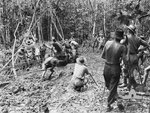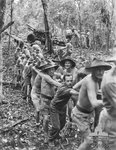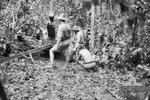Hello
a couple examples on Finnish army units marching deeds in Summer 44 in area between Lake Lagoda and Lake Onega
Infantry
I/15th Brigade
disengaged from village Sammatus at 6.15 on 25 Jun 44, after delaying the reinforced Soviet 100th GuardRD for one day there, (part of it had marched and fought delaying actions across 50km stretch during preceding 2 days), marching to Nurmoila village (25km) into which it arrived at late evening 25 Jun because it was forced to take defensive postures several times during the march. Next day the retreat continued, now a 40km march to Vitele, the march route was nothing more than a track and the march was made under constant air attacks. The battalion arrived very early on 27 Jun at Vitele, where it was ordered to go and take responsibility of the defence between Lake Ladoga and the Vitele railway bridge. Soviets attacked at noon, then 2½ days of hard defensive fighting and then the retreat continued.
ARTILLERY
Artillery of the 15th Br, 2 battalions of 76mm field cannons and one battalion of 152mm heavy hows, all horse drawn but the heavy howitzer batteries each had one small caterpillar to help in moving their heavy hows to and from firing positions, it had only arrived on 23 Jun at Pisi, now it had to retreat fast using the only road usable in the area, part of it (appr 20km) was only half-ready field road through swampy forests and in places the route ran across vast expenses of fields. The reasons of this were a Soviet landing NW of Finnish positions which had cut the main road and the railway to NW (to Finland proper) and powerful Soviet forces were also advancing fast to the E of the Finnish forces in question (15th Br and 5th Div). The heavy hows began to their retreat at 17 on 24 Jun 44 Soviets fallowing very near, on 26 Jun one of the batteries lost 2 of the heavy hows after its caterpillar was given away to tow a bus full of WiAs, one how. got stuck into mud, another lost its team of horses in one of the numerous air attacks against the marching columns of the brigade and the division, all using the same route.
At the dawn of 27 Jun the heavy howitzer battalion was at Rajakontu and it dig in near the church of Salmi on 28 Jun 44, that means over 75km march in a little under 2½ days and overr 100km in a little over 3 days, last 30km were normal retreat behind temporary solid front.
Juha
a couple examples on Finnish army units marching deeds in Summer 44 in area between Lake Lagoda and Lake Onega
Infantry
I/15th Brigade
disengaged from village Sammatus at 6.15 on 25 Jun 44, after delaying the reinforced Soviet 100th GuardRD for one day there, (part of it had marched and fought delaying actions across 50km stretch during preceding 2 days), marching to Nurmoila village (25km) into which it arrived at late evening 25 Jun because it was forced to take defensive postures several times during the march. Next day the retreat continued, now a 40km march to Vitele, the march route was nothing more than a track and the march was made under constant air attacks. The battalion arrived very early on 27 Jun at Vitele, where it was ordered to go and take responsibility of the defence between Lake Ladoga and the Vitele railway bridge. Soviets attacked at noon, then 2½ days of hard defensive fighting and then the retreat continued.
ARTILLERY
Artillery of the 15th Br, 2 battalions of 76mm field cannons and one battalion of 152mm heavy hows, all horse drawn but the heavy howitzer batteries each had one small caterpillar to help in moving their heavy hows to and from firing positions, it had only arrived on 23 Jun at Pisi, now it had to retreat fast using the only road usable in the area, part of it (appr 20km) was only half-ready field road through swampy forests and in places the route ran across vast expenses of fields. The reasons of this were a Soviet landing NW of Finnish positions which had cut the main road and the railway to NW (to Finland proper) and powerful Soviet forces were also advancing fast to the E of the Finnish forces in question (15th Br and 5th Div). The heavy hows began to their retreat at 17 on 24 Jun 44 Soviets fallowing very near, on 26 Jun one of the batteries lost 2 of the heavy hows after its caterpillar was given away to tow a bus full of WiAs, one how. got stuck into mud, another lost its team of horses in one of the numerous air attacks against the marching columns of the brigade and the division, all using the same route.
At the dawn of 27 Jun the heavy howitzer battalion was at Rajakontu and it dig in near the church of Salmi on 28 Jun 44, that means over 75km march in a little under 2½ days and overr 100km in a little over 3 days, last 30km were normal retreat behind temporary solid front.
Juha
Last edited:



